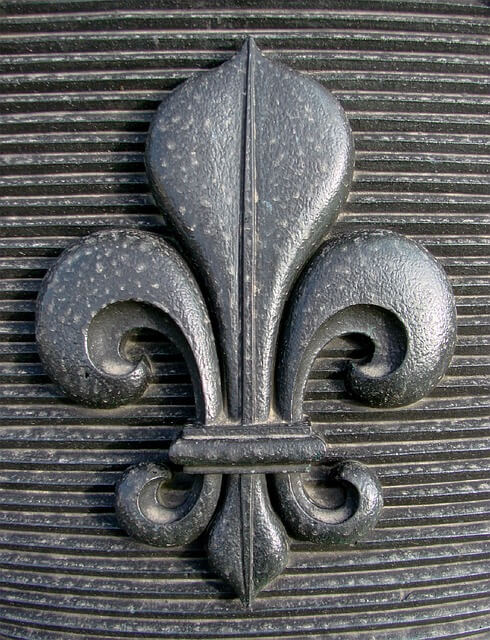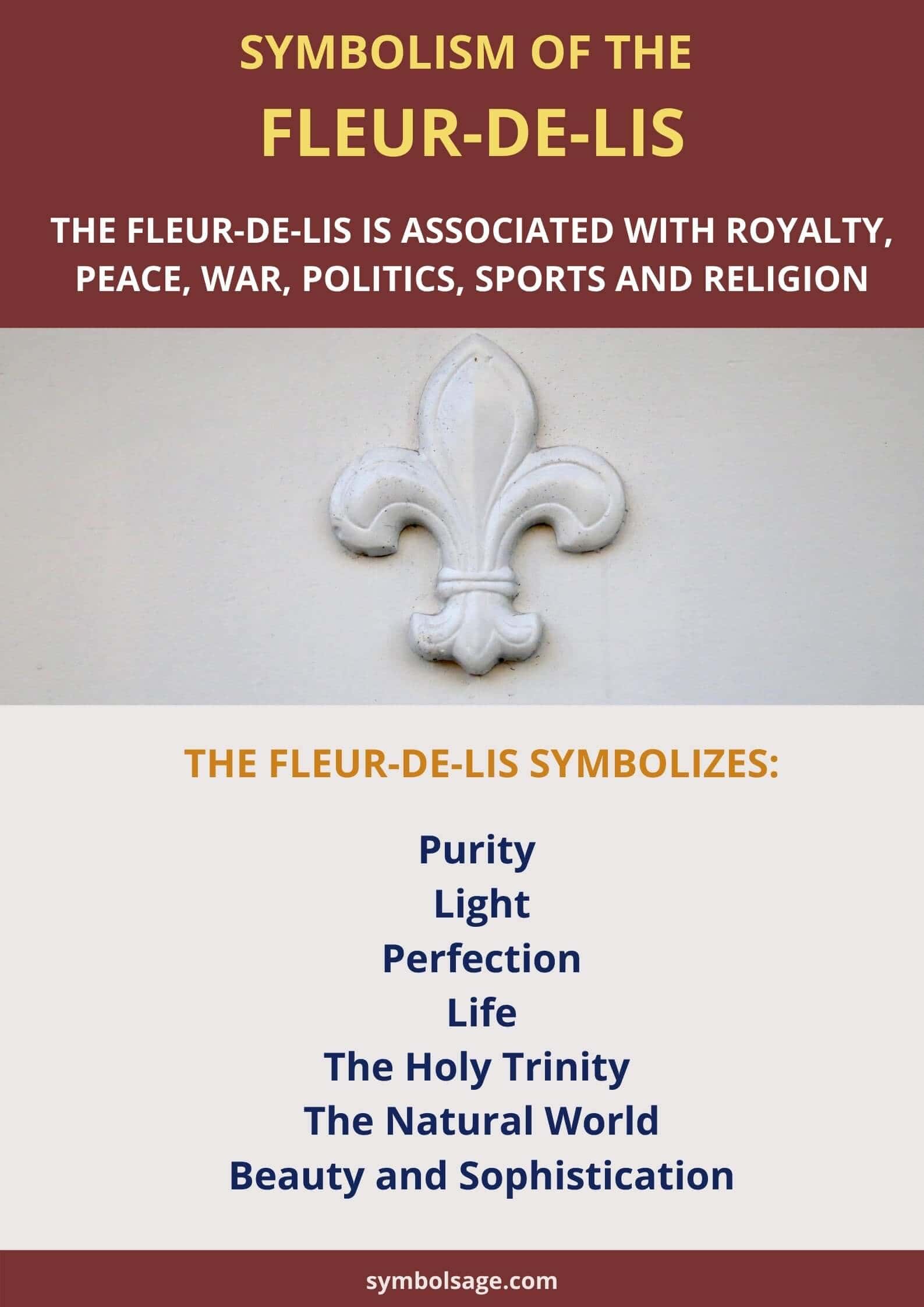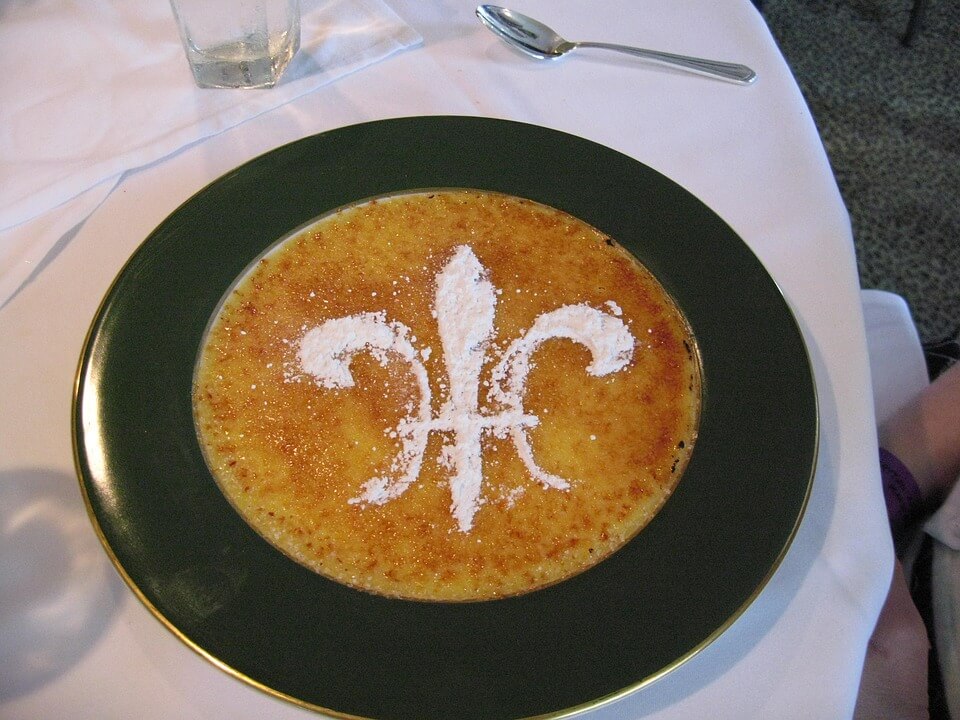
Table of Contents
The Fleur-de-Lis is everywhere and is one of the most ubiquitous symbols there is, so much so that it’s often not even noticed. The popularity of the Fleur-de-Lis comes in part from its majestic design and the symbol is commonly found in architecture, decorative items, fashion, logos and coats of arms today. Here’s how it originated and what it represents.
Fleur-de-Lis Origin and Design
We can’t attribute the creation of the Fleur-de-Lis to one civilization or location, as its exact origin is unknown. References to it can be found in historical documents from Babylonia, India, Rome, and Egypt. The symbol had various meanings throughout these different stages of history and was known by different names.
The symbol is most commonly associated with France and gets its name from the French for lily flower. The visual representation is a stylistic rendering of a lily or lotus flower. Lis-de-jardin or garden lily refers to non-stylistic, accurate images of lilies.

The Fleur-de-Lis has three petals with a larger pointed center petal and two leaves breaking off from it. As the design of the Fleur-de-Lis has been influenced by the limitations and tastes of craftsman, there are several variations to the symbol.
Occasionally, these variations have been given names to attempt to distinguish them from one and another, like the Fleur-de-Lis remplie, which represents the arms of Florence by the three petals separated by two stamens. Also, Charles V commanded the creation of the France Modern design of three fleurs-de-lis in 1376, possibly in honor of the Holy Trinity.
Symbolism of the Fleur-de-Lis
With the many uses of the Fleur-de-Lis, it is hard to find a signal meaning of the symbol itself. The main associations of the symbol come from the lily and anything connected with triplicities. The symbol has been associated with:
- Royalty
- Peace
- War
- Politics
- Sports
- Religion
It’s believed to symbolize:
- Purity
- Light
- Perfection
- Life
- The Holy Trinity
- The natural world
- Beauty and sophistication
The Fleur-de-Lis can be found in ancient art, architecture, fashion, jewelry, and sports. It’s always been known as a decorative element, which is part of the reason why it is a popular symbol in jewelry, especially in vintage-inspired pieces. In New Orleans, the Fleur-de-Lis has become a popular tattoo, especially since Hurricane Katrina.

Fleur-de-Lis and Christian Symbolism
While some Christians view the Fleur-de-Lis as a pagan symbol and do not accept it, it is considered a Christian Catholic symbol.
- Due to the lily representing purity, since antiquity the Roman Catholic church, has used the lily as a distinctive emblem of the Virgin Mary.
- The three-petal design of the symbol represents the Holy Trinity with the base representing Mary. In fact, up until the 1300s, depictions of Jesus contained the Fleur-de-Lis.
- Another link to Christianity comes from the legends surrounding the origin of the symbol. One legend states that the Virgin Mary gave a lily to Clovis, the King of the Franks. Yet another legend says that it was an angel that presented a golden lily to Clovis. In both cases, it represented his conversion to Christianity and the resulting purification of his soul.
Fleur-de-Lis and Royal Use

The Fleur-de-Lis’ use by noble families, like the French royal family, represents their connection to the church. On the other hand, English Kings adopted the symbol into their coats of arms to show their claim to the throne of France.
The Fleur-de-Lis as an emblem of the French royal family can be found on the seal of Philip I. On the seal, he is depicted as sitting on a throne with a staff ending with a Fleur-de-Lis.
Additionally, the Fleur-de-Lis was featured on the signet ring of Louis VII. Louis VII is also the first known King to have the auze seme of fleurs-de-lis (designated France Ancient) on his shield. Still, the symbol may have previously been in use on banners for other royal family members.
Fleur-de-Lis and Coat of Arms and Flags
In the 14th century, the Fleur-de-Lis was a common element of family insignias used by knights for identification after a battle.
Fun fact: The coat of arms gets its name from the fact that knights wore their symbol on their surcoat over their chainmail. Coats of arms became a social status symbol, and the Herald’s College was established in 1483 by King Edmund IV to supervise the granting of coats of arms.
The Fleur-de-Lis is also a part of the coat of arms for Spain, dating to its connection with the French houses of bourbon and Anjou. Canada also has the Fleur-de-Lis as part of their coat of arms, symbolizing the influence of their French settlers.
French settlers brought the symbol to North America, and its presence on flags generally means that French descendants settled the area. The Fleur-de-Lis is on the Franco-American flag, first used in 1992, and has blue, red, and white colors on it to represent the USA and France. The symbol is also present on the flags of Quebec and New Orleans.
Fleur-De-Lis Boy Scouts
The Fleur-de-Lis is the central part of the Scouts logo after first being used by Sir Robert Baden-Powell. Baden-Powell initially used the symbol as armbands to identify soldiers who qualified as scouts. He then used the emblem on badges that he gave to the boys attending the first Boy Scouts camp. He later revealed that he had a few reasons for choosing the symbol.
- The symbol resembles the arrowhead on the compass that points North just as the Boy Scouts logo points you upward and in the right direction.
- The three petals/points of the symbol represent the three parts of the Scout Promise.
- Some people also believe the logo represents the outdoors, a big part of the Scouts program.
Other Uses of the Fleur-de-Lis and Fun Facts
- Education: Following along the lines of a family coat of arms, the Fleur-de-Lis is on the coat of arms for various universities like the University of Louisiana and St. Paul’s University in the Philippines. The Fleur-de-Lis is also a symbol of American sororities and fraternities such as Kappa Kappa Gamma, Sigma Alpha Mu, and more.
- Sports Teams: The symbol is part of the logo for a few sports teams, particularly teams from areas where the Fleur-de-Lis is on their flag, such as in New Orleans, Louisiana.
- Military: Fleur-de-Lis symbol is featured on military badges of individual regiments of the United States military. Historically, the symbol was also present for select regiments of the Canadian, British, and Indian Army, often concerning the First World War. The Fleur-de-Lis represents military power.
- Joan of Arc led the French troops to victory over the English while carrying a white banner with the Fleur-de-Lis.
- The pointed design is a popular topper for wrought iron fence posts as a deterrent for would-be intruders while still being stylish.
Wrapping It All Up
Whether you want a symbol that represents history, heritage, or simply one known for its design the Fleur-de-Lis is a great choice. The design has been around for a long time and shows no sign of going away.








